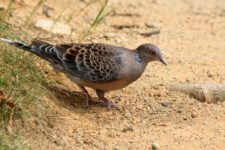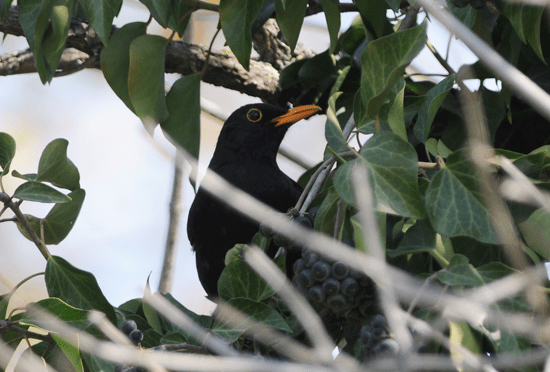Passereau très répandu et très familier. Il mesure en moyenne 24-25 cm de long et son envergure est de 34-39 cm. Ces valeurs moyennes varient selon les différentes sous-espèces (races) identifiées à cette date soit 15 au total.
Merle Noir
Adulte
Merle Noir
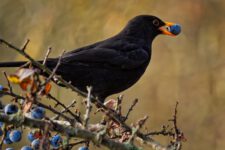
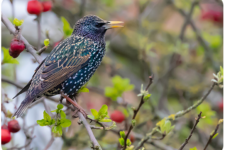
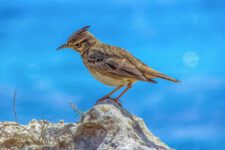
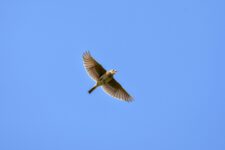
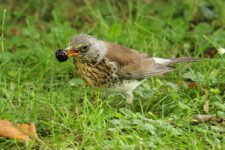
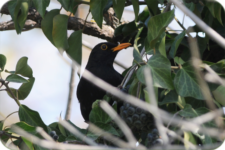
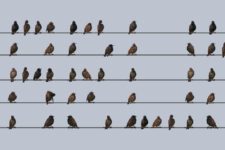
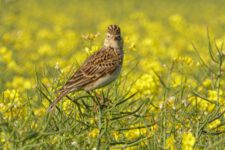
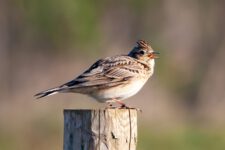
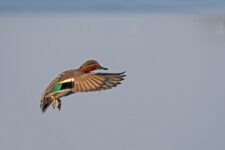
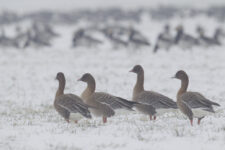
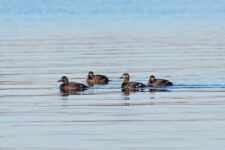
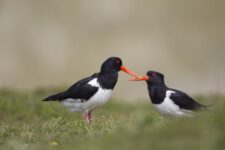
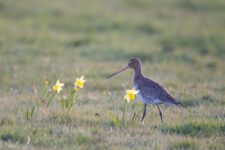
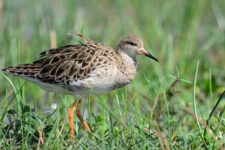
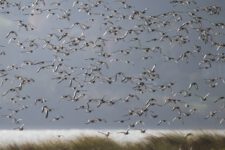
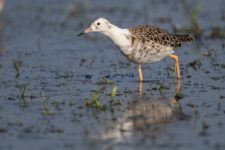
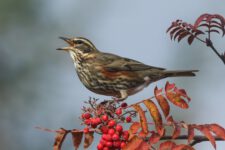
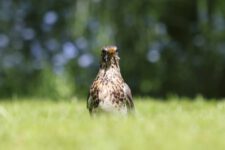

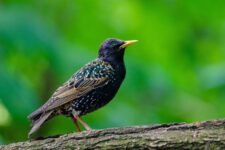
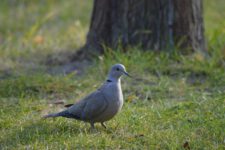
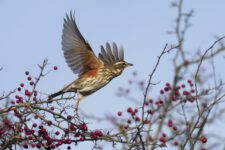
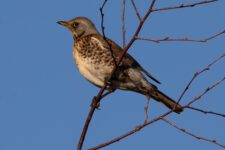
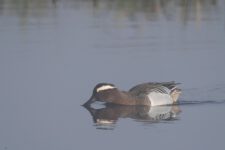

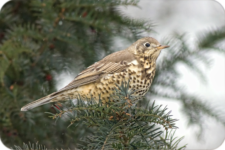
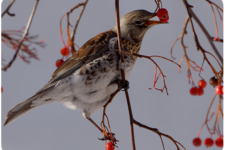
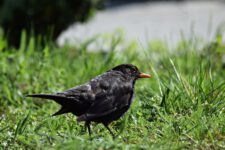
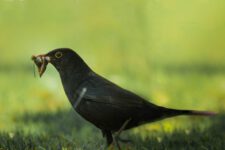
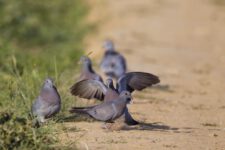
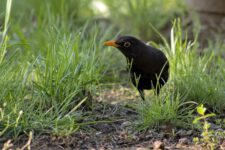
Espèce : Turdus merula (L.1758) : Merle noir – Blackbird – Mirlo comùn – Merlo
Directive 79/409 : Annexe II-2
Convention de Bern : Annexe III
Convention de Bonn : Annexe II
Etat de conservation en Europe : SPEC : catégorie 4 (favorable)(BLI.2004)
Statut en Europe : Sécurisé (BLI.2004)
Description et Identification
Passereau très répandu et très familier. Il mesure en moyenne 24-25 cm de long et son envergure est de 34-39 cm. Ces valeurs moyennes varient selon les différentes sous-espèces (races) identifiées à cette date soit 15 au total. Le poids varie aussi géographiquement mais aussi selon le sexe et la saison. En moyenne, le mâle pèse 80-149 g et la femelle 80-140g. Le mâle adulte est tout noir avec le bec et le cercle orbital jaune. La femelle est brun-gris à brun olive sombre, avec le centre de la gorge plus pâle et des discrètes mouchetures noirâtres sur la poitrine. Le bec est généralement brun terne mais peut être jaune chez certaines. Les juvéniles (1ère année) sont brun roussâtre avec le corps moucheté de chamois. Le bec est brun terne. Les jeunes muent en fin d’été et ont alors le corps noirâtre et la tête rousse.
Quelques exemples de “sous-espèces ou de races”(in 4) :
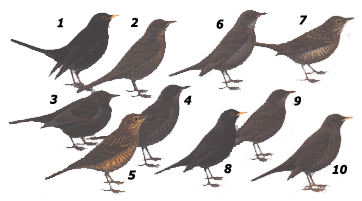
Turdus merula merula: (1 = mâle ad : 2 = femelle ad : 3 = mâle ad (premier automne) : 4 = mâle ad (premier automne variété : stockhamsel) : 5 = jeune
T.m.syriacus: 6 : femelle ad ; 7 : jeune
T.m.azorensis: 8 : mâle adulte ; 9 : femelle ad
T.m. mauritanicus: 10 : femelle ad.
La voix: les cris du merle noir comprennent un «tchac-tchac-tchac » sourd, s’accélérant et durant plusieurs secondes quand l’oiseau adopte un comportement d’alarme. Il émet aussi un «tchic-tchic-tchic «aigu, répété, au dortoir ou quand il est inquiet. Le cri de vol (migration ou déplacements erratiques) est un «tsîîh-tsîîh «fin qui peut être aussi émis quand il est en posture d’écoute d’un danger ou d’un congénère voisin. Le chant nuptial (territorial), émis de mars à août, est mélodieux et flûté mais moins répétitif que chez la Grive musicienne. Les différentes «races «ont développé des variantes à ce répertoire correspondant à T. m. merula.
Répartition Géographique
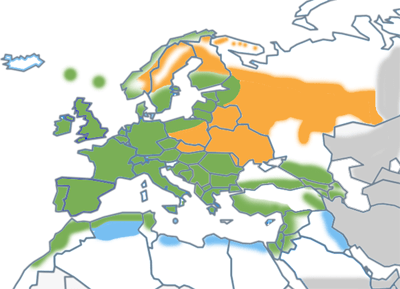
Répartition géographique des «sous-espèces ou races «: T.m.merula : toute l’Europe, de l’Islande ou des Iles Britanniques à l’est jusqu’à l’Oural. Au sud, Péninsule Ibérique, Baléares, France ,Corse , Sardaigne , Italie , Sicile , Balkans. Introduite en Nouvelle Zélande et en Australie. T.m.azorensis : Açores ;T.m.cabrerae : Madeire et Iles Canaries ; T.m. mauretanicus : centre et nord du Maroc , Algérie jusqu’au nord de la Tunisie ; T.m.aterrinus : Hongrie et les Balkans, sud de la Grèce , Crète , Caucase et nord de l’Iran ; T .m.syriacus : crête méditerranéenne de la Turquie , ouest de la Syrie , nord et centre d’Israël ; T.m.intermedius : centre de la Russie, ouest et nord de l’Afghanistan ; T.m.maximus :est de l’Afghanistan , Pakistan, sud du Tibet, erratique nicheur dans le Népal ; T .m.mandarinus : centre de la Chine , récemment jusqu’au Cambodge ; T.m.sowerbyi :centre du Szechwan; T.m.nigropileus : ouest de l’Inde jusqu’au sud du Rajasthan ; T.m .spencei : est de l’Inde ; T.m.simillimus : sud-ouest de l’Inde ; T.m.bourdillioni : au sud de simillimus ; T .m .kinnisii :Sri Lanka.
Détermination de l’âge et chronologie de la mue : outre les critères de plumage mentionnés précédemment, on peut distinguer l’adulte.
(Ad) du jeune dans sa première année (1Y) par l’examen de la première rectrice (central. 1st TF.) : cf : figure (in 16).
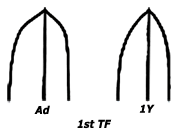
La mue des adultes est complète après la saison de reproduction, d’août à début novembre. Certains individus peuvent ne terminer leur mue qu’en décembre. Les populations méridionales muent plus précocement que les populations septentrionales. Les juvéniles ont une mue incomplète (tête, corps, moyennes couvertures) environ 6 semaines après l’envol, soit de juillet à fin août. Leur mue est complète en octobre.
Habitat et Alimentation
Espèce commune à large répartition et donc large amplitude d’habitat. Elle habite les forêts caducifoliées( hêtraie, chênaie..) ou sempervirentes (pins , chêne vert , chêne liège..) mais toujours avec un sous-bois arbustif ; maquis , garrigues , landes avec moins d’arbres mais des arbustes pouvant atteindre 2m notamment landes à genévriers , filaires , ronces ; lisières «forêts-plaine cultivée «; zones agricoles avec des grandes haies et ruisseaux , parcs et jardins avec une nette tendance à l’accroissement des populations en zones urbaines et suburbaines. Le merle noir est aussi présent sur les petites îles, les fourrés côtiers.
Il évite les grandes plantations de conifères sans sous bois et préfère les habitats en mosaïque où alternent champs cultivés, haies, bosquets. En revanche il s’est bien adapté aux conséquences «du gel des terres «sur les habitats et profite notamment de la multiplication des friches avec un développement d’arbustes à baies utiles à son alimentation.
En Europe, il peut vivre au dessus de 1000m mais à plus de 4000m dans le Tien Shan et dans l’Himalaya et à 4600m d’altitude dans l’ouest de la Chine. En Afrique du nord il est présent jusqu’à 2300 m d’altitude.
Son alimentation varie au cours des saisons mais est composée d’insectes et leurs larves , araignées , myriapodes , petits escargots , vers de terre et de fruits : pommes , poires , cerises , fraises , framboises , groseilles, baies de cotoneaster , de lierre , de genévriers ,de sorbier des oiseleurs , de mures , d’if , de gui , de houx , de sureau . En zone méditerranéenne dans les maquis et garrigues, ce sont surtout les baies de genévriers (Juniperus sp avec notamment J. communis , et J. oxycedrus) , de filaire (Phillyrea angustifolia et P. media) , de garance voyageuse (Rubia peregrina), qui sont consommées notamment en automne pendant la migration et l’hivernage. Ces indications sont à prendre en compte pour le choix d’espèces végétales à planter dans le cas de reconstitution de haies qui restent en zone agricole l’habitat préféré du merle noir. Le raisin arrivé à maturité en septembre ou laissé sur pied en petites grappes après les vendanges représente une part importante de l’alimentation en automne dans les zones cultivées.
La consommation de petits vertébrés (lézards, grenouilles, petits poissons) peut intervenir occasionnellement.
Reproduction
La période de reproduction s’étend de mars à fin août ; pour les «races «les plus orientales, celle-ci débute d’avril à juillet (simillimus : mars-août ; bourdillioni et kinnisii : avril-juin ; nigropileus : juin-septembre). Le début de la reproduction est corrélé avec la latitude : 2 semaines plus tard en Ecosse que dans le sud de l’Angleterre. En Tchéquie, la ponte débute au cours de la dernière décade d’avril. En France continentale la reproduction débute au cours de la troisième décade de février et en Corse au cours de la deuxième semaine de mars (7 ; 10).
Le nid est construit par la femelle. C’est une cavité de 15cm de diamètre environ, (12cm de haut et 7cm de profondeur) couverte d’herbe, de paille, de brindilles, de mousse, assemblés par de la terre . Il est plutôt situé à la fourche d’un arbuste ou d’un petit arbre à une hauteur moyenne (N=1589) de 1.9m. Dans 1% seulement des cas, le nid est construit à même le sol notamment chez les «races «vivant en altitude. Les œufs ont des colorations variables soit unicolore (pâle, légèrement bleuté) soit tachetés de roux. (cf : figure avec 6 cas différents, in 4)

Le poids moyen est de 7.2 g sans différence significative entre les oiseaux originaires d’Espagne ou T .m.cabrerae et ceux d’Europe centrale (T.m.merula).
La taille de la ponte est 3 à 5 œufs (2-6). En Angleterre, la moyenne (N=1904) est de 3.87 par nid. La taille des pontes varie selon la saison : 3.4, en mars ; 4.56, en mai et 3.61, en juin-juillet. Les pontes des femelles de première année sont inférieures (3.4) à celles des femelles adultes (3.8). Deux à trois couvées sont fréquentes à l’exception du nord de l’aire de répartition (2 en général). Les œufs sont pondus chaque jour. La ponte dure en moyenne 2.4 jours. En début de saison (mars) cette durée est supérieure. L’incubation dure en moyenne 13 jours (12.6 en Tchéquie, 13.7 en Angleterre). Elle est assurée par la femelle bien que le mâle ait pu être observé sur le nid. Les jeunes sont nourris par les deux parents pendant 3 semaines (19.6 jours en moyenne). L’envol a lieu 14 jours en moyenne après l’éclosion. L’âge à la première reproduction est de un an. Les femelles adultes sont plus productives que les femelles de première année.
Le taux moyen de perte des nids est 35.7% avant l’envol. Les causes principales de perte des nids sont la prédation, l’abandon et l’infertilité. Le nombre moyen de jeunes élevés par couple est de 3.46 en zone suburbaine et de 2.61 en zone rurale. Une étude Suédoise a montré que sur 146 œufs pondus : 54% ont éclos, 39% du nombre de départ ont produit des jeunes à l’envol, 32% au delà de 5 jours après l’envol et 27% jusqu’à l’indépendance soit 16 jours après l’éclosion.
Populations
Une synthèse européenne récente (2) situe les effectifs de couples entre 40 et 82 millions dans 44 pays. En France les effectifs se situent entre 1 et 6 millions de couples ; en Espagne : 2.3 à 5.9 millions ; en Grèce : 0.8 à 2 millions ; en Italie : 2 à 5 millions ; au Portugal : 0.2 à 2 millions. La plus forte population est celle de l’Allemagne : 8 à 16 millions de couples, suivie par celle du Royaume Uni : 4.9 millions de couples.
Les tendances actuelles, telles que définies par le Bird Life International, permettent de classer l’espèce en catégorie 4 : état de conservation favorable et statut sécurisé en Europe.
Parmi les 44 pays concernés par la synthèse de 2004, l’espèce est stable ou en augmentation dans 38 d’entre eux dont ceux accueillant la majorité des effectifs européens. Elle est en diminution dans 3 pays : Albanie, Croatie et Turquie.
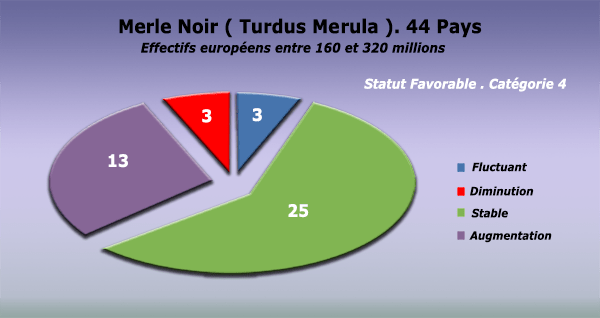
En admettant une production moyenne de 2 jeunes par couple avant le départ en migration, on peut estimer les effectifs européens avant le départ en migration se situant entre 160 et 320 millions d’individus dans la partie du Paléarctique occidental concernée par 44 pays (6 ; 17).
Taux de mortalité
Les taux de mortalité varient selon les pays. En Angleterre où l’espèce n’est pas chassée, le taux de mortalité est de 58% la première année, 38% la seconde, 50% la troisième et 40% les quatrième et cinquième. La mortalité annuelle a diminué de 1951-1952 (50%) à 1960-1961 (32%).Le trafic routier et les chats harets jouent un rôle de plus en plus important dans les causes de mortalité. En Belgique, le taux annuel de mortalité est de 69% : la mortalité adulte est de 52.2% ou de 46% en excluant les causes de mortalité dues à l’homme (chasse, trafic routier). La mortalité juvénile est de 12.4%. En France la mortalité annuelle en zone urbaine est de 25% chez les mâles et 33% chez les femelles. En Allemagne ce taux est de 49% et de 28% pour les populations urbaines ; en Finlande, le taux annuel est de 58-59% ; en Tchéquie, il est de 68.4% la première année de vie, 56.3% la seconde et de 30% la troisième. Contrairement aux autres espèces du genre Turdus, le merle noir semble peu affecté par les hivers rigoureux. Le plus vieil oiseau bagué connu a atteint l’âge de 20 ans et 3 mois.
Mouvements dans le Paléarctique Occidental
L’espèce est composée de populations sédentaires et migratrices, les populations nordiques se déplaçant plus au sud en automne et en hiver selon les conditions météorologiques.
En général les populations de Scandinavie, Angleterre, Irlande, Danemark et Allemagne hivernent en Europe de l’ouest et les populations plus méridionales hivernent au sud de l’Europe.
Les oiseaux originaires d’Allemagne, de Pologne, de Tchéquie, de Suisse et de Hongrie migrent au sud -sud-ouest : dans l’ouest de la France, en Espagne, Portugal ,Baléares,Corse, nord de l’Italie et Malte.
En hiver, les oiseaux originaires du nord de l’Europe se déplacent jusqu’à Gibraltar, au Maroc, Algérie, Tunisie en empruntant la côte méditerranéenne. En Russie, une fraction de la population reste dans le pays en hiver mais la plupart migre plus au sud et à l’est (Chypre, Turquie). La «race aterrimus «du sud-est de l’Europe, Caucase et Turquie hiverne en Egypte et à Chypre. Les mouvements de la « race mauritanicus «sont peu connus mais des reprises de bagues au Maroc et dans le sud de la Tunisie, laissent supposer des déplacements.
La «race syriacus «est présente de novembre à mars le long de la Méditerranéen orientale, dans le Sinaï. Quelques cas sont signalés au Soudan, en Jordanie et dans les Pays du Golfe.
Les populations les plus orientales sont sédentaires ou réalisent de courts déplacements selon l’altitude ou la latitude. En novembre 1994, le premier merle noir a été trouvé mort aux Etats Unis ( Bonavista, Newfoundland) et est considéré comme le premier cas d’erratisme au long court de l’Europe vers le nouveau continent.
Le merle noir se déplace (migration et erratisme hivernal) de nuit mais aussi de jour. En migration d’automne (post nuptiale) de nombreux cas de mortalité sont enregistrés en Mer du nord dans les puits de pétrole «offshore «. La migration d’automne débute en fin septembre au nord avec un passage intense en octobre qui se poursuit jusqu’en début novembre. Les jeunes peuvent se déplacer dès juillet-août. Les départs de la Russie commencent à la mi-septembre et se poursuivent jusqu’en novembre ce qui explique la succession des passages enregistrés plus au sud en zone méditerranéenne par les stations bioacoustiques installées dans le bassin méditerranéen et fonctionnant toutes les nuits (6 ; 12). En Angleterre et en Irlande on constate, en janvier-février, régulièrement une augmentation des reprises d’oiseaux originaires de Suède. Plusieurs cas de migration inverse ont pu être notés : oiseaux bagués à Helgoland repris 24 jours après au Danemark, Norvège et dans l’Ile de Fair.
La migration de retour (pré nuptiale) débute pour toutes les «races «fin février, avec un premier «pic «début mars et ensuite des passages successifs jusqu’en avril voire certains cas début mai (3 ; 4). Des recherchesrécentes utilisant la bioacoustique associée avec des dénombrements au sol , montrent pour la France (sud-sud est ) , l’Espagne et l’Italie ( Arosio, Udine) , que le tout début de la migration intervient au cours de la dernière décade de février et que les «pics «de migration se succèdent , selon l’origine des oiseaux , jusqu’à la mi-avril (6 ;8 ;9 ;11 à 18).
Pendant les migrations (post et pré nuptiales) , les oiseaux ont une nette tendance au grégarisme et réalisent leur vol en petits groupes de 5 à 20 individus (9) restant en contact visuel ou auditif pendant la nuit en émettant un cri caractéristique «tsîîh-tsîîh «fin et traînant , un peu plus léger que celui émis par la Grive mauvis. Les dates d’arrivée dans l’aire de reproduction varient selon les régions d’Europe. En Suède, les premières arrivées ont lieu en fin avril ; en Russie, elles s’étalent de début mars à début mai ; en Lituanie – Estonie-Ukraine, elles ont varié du 12 mars au 12 avril pour la période 1971-1984 (4 ; 21).
Chasse-gestion des Populations et des Habitats
Le merle noir est chassé traditionnellement dans la partie méridionale de l’Europe depuis des temps immémoriaux selon différents modes de chasse avec ou sans appelants, devant soi ou au poste fixe.
Les prélèvements par la chasse sont encore imparfaitement connus. Cette espèce est chassée en France, Grèce et Italie parmi les pays de l’Union Européenne. Pour la France, les prélèvements au cours de la saison cynégétique 1998/1999 (enquête ONCFS/UNFDC) ont été estimés à 980 000 (± 3.3%) ce qui représente entre 0.3 et 0.6% des effectifs européens estimés (cf : supra. Populations). Il conviendra à l’avenir de mieux connaître les prélèvements réalisés sur cette espèce en Europe notamment par l’instauration d’un carnet de prélèvement tel qu’il est déjà en application en Grèce et en Italie assorti de mesures de gestion par l’instauration d’un quota saisonnier de prélèvement ajusté sur les stocks européens et les résultats relatifs au succès de la reproduction d’ailleurs déjà en application pour l’exercice de la chasse traditionnelle de cette espèce. Cet objectif nécessite une forte collaboration entre les pays concernés par l’aire de reproduction (centre et nord de l’Europe) et ceux concernés par l’hivernage (sud de l’Europe et Afrique du nord).Les organismes de recherches gouvernementaux et non gouvernementaux, en collaboration avec les instances européennes et nationales de chasse, devront donc assurer un suivi à long terme et une coordination indispensable.
La conservation de cette espèce dont le statut est très favorable à l’échelle du Paléarctique occidental (2) passe aussi par une diminution des causes de mortalité à tous les stades biologiques notamment pendant la migration (plates-formes pétrolières » offshore « , phares, lignes à haute et moyenne tension, trafic routier) et en diminuant la prédation notamment sur les nids et les poussins.
La conservation des habitats tant de reproduction que de migration (haltes migratoires) ou d’hivernage doit être une priorité. Le régime alimentaire du merle noir est très varié, ce qui constitue un avantage considérable puisque sa niche écologique alimentaire permettra de développer selon les régions des ressources variées et complémentaires. Parmi les priorités on peut citer : la conservation des haies et des bosquets , le développement d’une sylviculture tolérant une strate arbustive , l’entretien des espaces méditerranéens incultes en favorisant un paysage en mosaïque où alternent , milieux ouverts et milieux fermés , en encourageant dans les plans de reboisement , la plantation d’arbres ou d’arbustes à baies , base de l’alimentation printanière et hivernale de l’espèce , la plantation de haies de structure (strates) et de composition efficace (espèces) d’ailleurs pouvant être financée par la politique agricole commune (PAC) notamment par les mesures agri-environnementales au niveau européen et les aides des états membres ou des régions de programme.















